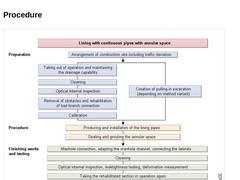
|

| (Image: Sequence diagram for the lining with continuous pipes with annular space)
|
|

|

| (Image: Equipment for lining with prefabricated pipes with anular space)
The lining with continuous pipes with annular space requires the following equipment: - Staff of 4-6 persons on construction site
- Possibly devices and machines for installing and securing the excavation (e.g. excavator, supporting elements)
- Heating element butt welding equipment and power set
- Winch with corresponding tensile strength
- Pulling head
- Roller blocks
- Lifting device
- Compulsory …
|
|
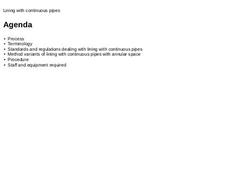
|

|

|

| (Image: Conventional sliplining process with annular space with reference to [FI-Teerb] - Depiction of principle [Image: S&P GmbH]) In this process, a correspondingly long, flexible continuous pipe of HD-PE with a circular cross section is pulled from an excavation into the pipe sector to be rehabilitated in one operation with the help of a winch . The remaining annular space between the liner and the inner wall of the sewer is grouted. |
|
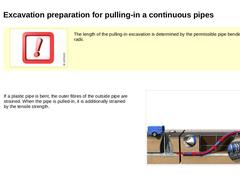
|

| (Image: Attention!)
The length of the pulling-in excavation is determined by the permissible pipe bending radii. | |
If a plastic pipe is bent, the outer fibres of the outside pipe are strained. When the pipe is pulled-in, it is additionally strained by the tensile strength. | (Image: Loads of outer fibres of the continuous pipe when pulled in)
|
|
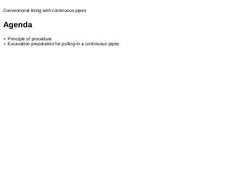
|

|
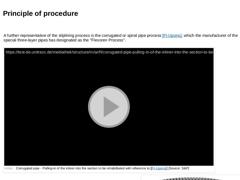
|

A further representative of the sliplining process is the corrugated or spiral pipe process (not found), which the manufacturer of the special three-layer pipes has designated as the "Flexoren Process". |
|
(Video: Corrugated pipe - Pulling-in of the inliner into the section to be rehabilitated) |
|
A pull head is attached to the end of the continuous pipe in order to make the pulling-in process easier and an insertion funnel is placed at the start of … |
|

|

|
(Image: Corrugated pipe process - Inserting the corrugated pipe into the entry manhole (Baypren) [FI-Phoena])
|
(Image: Corrugated pipe process - Guiding the corrugated pipe into the section of the sewer to be rehabilitated [FI-Upono])
|
|
|

|

|
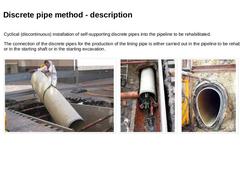
|

|
Cyclical (discontinuous) installation of self-supporting discrete pipes into the pipeline to be rehabilitated. The connection of the discrete pipes for the production of the lining pipe is either carried out in the pipeline to be rehabilitated or in the starting shaft or in the starting excavation. |
(Image: Installation of a GRP-discrete pipe into the starting excavation)
|
(Image: Taking-up and driving -in of the GRP pipes: step 2)
|
(Image: Driving-… |
|
|
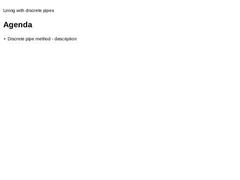
|

|
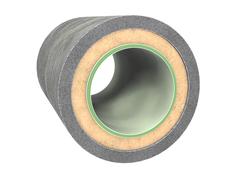
|

The lecture describes the different method variants and systems of lining with prefabricated pipes with annular space especially the lining with continuous and discrete pipes. |
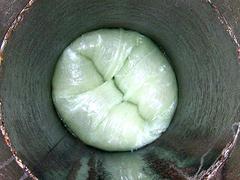
|
The renovation of sewers and pipelines with "Lining with cured-in-place pipes" is an established standard construction method, starting with the planning process, through material production and installation, right up to checking the quality achieved. It is characterized by a wide range of applications and a high variance in the fabrication and application processes. This module teaches the essential basics in relation to the fabrication of the lining tube and its installation. After completing this module, you will have a sound knowledge of: - range of application of tube lining
- damage patterns and application limits;
- requirements on materials, resin systems and carrier material;
- curing processes and procedures.
|

|
(Video: Lecture Video Lining with Cured-In-Place Pipes - basics) |
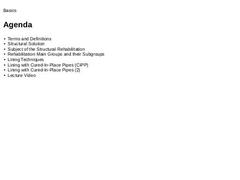
|
|
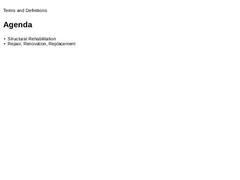
|
|
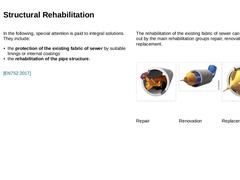
|
In the following, special attention is paid to integral solutions. These include: -
Protection of the existing sewer structure with suitable linings or internal coatings
-
Rehabilitation of the pipe structure.
The rehabilitation of the existing sewer structure can be carried out through main rehabilitation methods; repair, renovation or replacement. (Image: Picto Repair connections) (Image: Picto Renovation) (Image: Picto Replacement) |
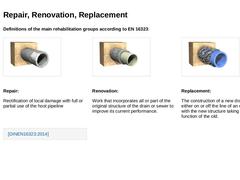
|
Definitions of the main rehabilitation groups according to EN 16323: (Image: Repair (Rectification of local damage) (Image: Lining with cured-in-place pipes) (Image: Replacement using trenchless technology (pipe bursting) ) Repair: Rectification of local damage with full or partial use of the host pipeline Renovation: Work that incorporates all or part of the original structure of the drain or sewer to improve its current performance. Replacement: The construction … |
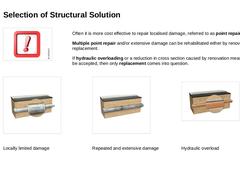
|
In many cases, repairing localized damage—referred to as point repair—is the most cost-effective option. When there are multiple instances of point repair or extensive damage, rehabilitation can be achieved either through renovation or replacement. If hydraulic overloading or a reduction in cross section caused by renovation measures cannot be accepted, replacement becomes the only viable option. (Image: Locally limited damage) |
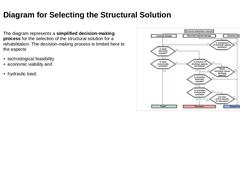
|
The diagram illustrates a simplified decision-making process for selecting the appropriate structural solution for rehabilitation. The decision-making process focuses on the following aspects: -
Technological feasibility
-
Economic viability
-
Hydraulic load
(Image: Decision process for the selection of structural solutions with reference to DIN EN 752-5 [DINEN752-5b]) |
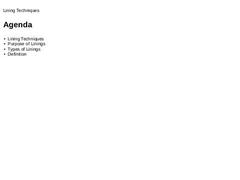
|
|
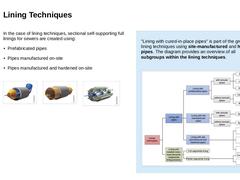
|
In the case of lining techniques, sectional self-supporting full linings for sewers are created using: (Image: Lining with prefabricated pipes) (Image: Lining with site manufactured pipes) (Image: Lining with site manufactured and hardened pipes) "Lining with cured-in-place pipes" is part of the group of lining techniques using site-manufactured and hardened pipes |
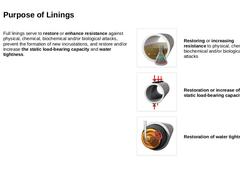
|
Full linings serve to restore or enhance resistance against physical, chemical, biochemical and/or biological attacks, prevent the formation of new incrustations, and restore and/or increase the static load-bearing capacity and water tightness. |
(Image: Picto Wastewater Type) |
Restoring or increasing resistance to physical, chemical, biochemical and/or biological attacks |
|
(Image: Picto Statik) |
Restoration or increase of the static load-bearing capacity |
|
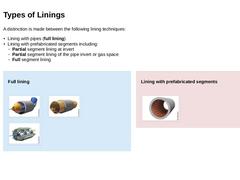
|
A distinction is made between the following lining techniques: -
Lining with pipes (full lining)
-
Lining with prefabricated segments including:
-
Partial segment lining at invert
-
Partial segment lining of the pipe invert or gas space
-
Full segment lining
Full lining (Image: Lining with prefabricated pipes) (Image: Lining with site manufactured pipes) (Image: Lining with site manufactured and hardened pipes) Lining with prefabricated segments (Image: … |
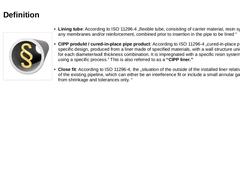
|
(Image: Icon: Recht) 1. Lining Tube A flexible tube consisting of carrier material, resin system, and optional membranes and/or reinforcement. These components are combined before the tube is inserted into the pipe to be lined [ISO 11296-4]. 2. CIPP Product (Cured-in-Place Pipe Product) A cured-in-place pipe of a specific design, produced from a liner made of specified materials. The wall structure is uniquely defined for each diameter/wall thickness … |